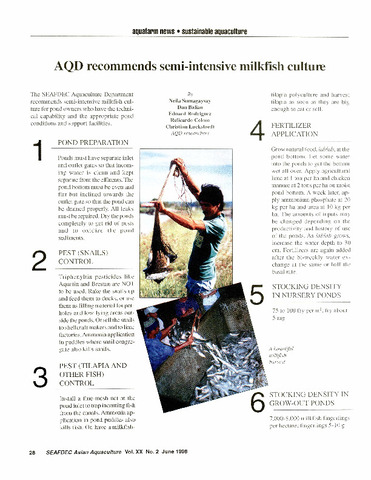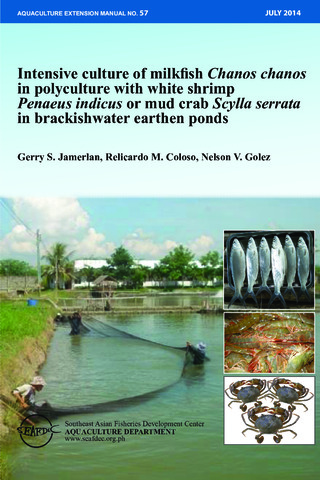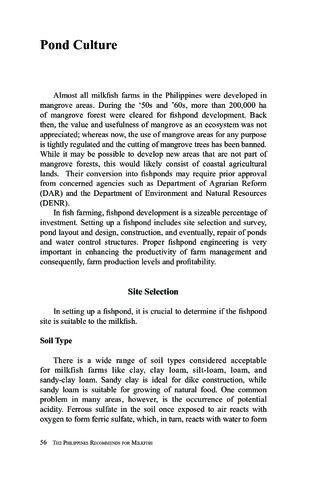| dc.contributor.author | Sumagaysay-Chavoso, Neila S. | |
| dc.contributor.author | San Diego-McGlone, Ma. Lourdes | |
| dc.date.accessioned | 2014-05-07T06:51:00Z | |
| dc.date.available | 2014-05-07T06:51:00Z | |
| dc.date.issued | 2003 | |
| dc.identifier.citation | Sumagaysay-Chavoso, N. S., & San Diego-McGlone, M. L. (2003). Water quality and holding capacity of intensive and semi-intensive milkfish (Chanos chanos) ponds. Aquaculture, 219(1-4), 413-429. | en |
| dc.identifier.issn | 0044-8486 | |
| dc.identifier.uri | http://hdl.handle.net/10862/2004 | |
| dc.description.abstract | This study determined the holding capacity of semi-intensive and intensive milkfish ponds and water quality in relation to fish biomass and feed input. Six units of 1000 m2 brackishwater ponds were used, three ponds for intensive system (20,000 fish ha−1) and three for semi-intensive system (8000 fish ha−1). Average production was significantly higher in intensive pond (3652 kg ha−1) than in semi-intensive pond (1352 kg ha−1) after a desired marketable size of fish was reached. Highest concentrations in effluents (mg l−1) of rearing water measured every 2 weeks were 0.369 and 0.289 for chlorophyll a (chl a), 0.485 and 0.512 for PO4–P, 0.279 and 0.811 for TAN, 0.094 and 0.082 for NO2–N, and 14.040 and 8.649 for NO3–N, 216 and 142 for total suspended solids (TSS), 15.0 and 21.7 for biological oxygen demand (BOD), in intensive and semi-intensive ponds, respectively. Lowest morning dissolved oxygen (DO) in intensive pond was 2.2 mg l−1, and did not decrease further because of aeration. In unaerated, semi-intensive pond, morning DO ranged from 1.3 to 5.0 mg l−1 but occasionally went below 1.0 mg l−1 resulting to fish mortalities at biomass of 835, 1206, and 1489 kg ha−1. Levels of NO3–N and dissolved inorganic N are linear functions of fish biomass or feed input in all systems (P<0.05). The buildup of nutrients is more pronounced at biomass of 1610 kg ha−1 and above while nutrient transformation (conversion of PO4–P or TAN to phytoplankton or vice versa) is apparent at biomass below 1419 kg ha−1. The holding capacity of unaerated, semi-intensive pond is below 1348 kg ha−1 or 54 kg feed ha−1 day−1 based on DO concentration of less than 1.0 mg l−1. However, the holding capacity can be lower than 835 kg ha−1 or 33 kg feed ha−1 day−1 during very calm weather or during rainy days when water column is stratified. Based on the results of regression analysis, the holding capacity of intensive pond should be set below 5107 kg ha−1 or 110 kg feed ha−1 day−1 so as not to exceed the acceptable levels for water quality variables in effluent waters. | en |
| dc.description.sponsorship | This work was financed by SEAFDEC/AQD. The authors would like to thank the Centralized Analytical Laboratory of SEAFDEC/AQD for some of the water, and feed analysis, Gwen Anuevo for the assistance, and Mila Castaños for editing the draft of the manuscript. | en |
| dc.language.iso | en | en |
| dc.publisher | Elsevier | en |
| dc.subject | Milkfish | en |
| dc.subject | Chanos chanos | en |
| dc.title | Water quality and holding capacity of intensive and semi-intensive milkfish (Chanos chanos) ponds | en |
| dc.type | Article | en |
| dc.citation.volume | 219 | |
| dc.citation.issue | 1-4 | |
| dc.citation.spage | 413 | |
| dc.citation.epage | 429 | |
| dc.citation.journalTitle | Aquaculture | en |
| dc.subject.asfa | aeration | en |
| dc.subject.asfa | dissolved oxygen | en |
| dc.subject.asfa | fish ponds | en |
| dc.subject.asfa | Intensive culture | en |
| dc.subject.asfa | nutrient cycles | en |
| dc.subject.asfa | Recirculating systems | en |
| dc.subject.asfa | stocking density | en |
| dc.subject.asfa | water quality control | en |
| dc.identifier.doi | 10.1016/S0044-8486(02)00576-8 | |
| dc.subject.scientificName | Chanos chanos | |



